Lunar New Year Festival
Tet means the first morning of the New Year in Vietnamese language. Vietnamese New Year begins on the first day of the first lunar month and used to last for seven days. It marks the arrival of spring and is the greatest celebration time as the festival brings along a few breaks in the agricultural year. Vietnamese New Year falls between the period of harvesting of crops and the sowing of the crops.
New Year Traditions and Customs
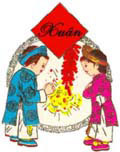
Vietnamese are very particular about their New Year traditions and customs. They follow all the customs earnestly and rigidly. Vietnamese believe, on this day their fate and luck for the New Year is determined. Children are told not to cry or fight and people who are in mourning are avoided.
Decorations for New Year
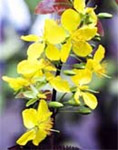
When New Year is near, people of Vietnam start cleaning their houses and ancestral graves. Houses are decorated with Hoa Mai (yellow flowering plant) which is supposed to bring prosperity and well-being for the family. Some people also hang a traditional painting depicting a tale of two lovers. Vietnamese consider Tet to be the time to pay off all debts and to resolve conflicts.
Parallel Sentences in Vietnamese New Year
Parallelism played an important role in Vietnamese classical literary style. It marks every literary genre from prose to poetry, including a kind of rhymed pose. It entirely governs a particular genre, call parallel sentences.
Vietnamese New Year Food
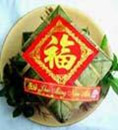
Vietnamese New Year food includes a special rice pudding called banh Chung or banh Tet prepared beforehand. The pudding contains mung beans and pork. Other New Year delicacies include preserved sweets, chicken, fish, oranges, beef, grapefruits, coconuts and some seasonal fruits. Watermelon is considered the most auspicious fruit of the season as it's flesh is red. Its dried seeds are also used for various delicacies.
The Plate of Five Fruits in Vietnamese New Year
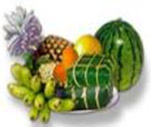
The "five-fruit tray" on the ancestral altar during the Tet Holidays symbolizes the admiration and gratitude of the Vietnamese to Heaven and Earth and their ancestors and demonstrates their aspiration for a life of plenty. The five fruits represent the quintessence hope that Heaven and Earth bless humans. It demonstrates a Vietnamese percept of life, "When taking fruit, you should think of the grower".
Cay Neu - The New Year Tree
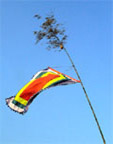
A tradition of displaying a New Year Tree is performed with sanctity and devotion. The tree is called Cay Neu. A bamboo pole decorated with bells, flowers, good luck charms and streamers is placed in front of the house. The red color is considered lucky by the Vietnamese to scare off the evil the spirits. This is the last ritual, le khai ha performed on the seventh day of the Tet.
New Year Celebrations
People like to celebrate the first day of the New Year with their families and friends. They wear new clothes and children give traditional greetings to their elders before receiving the New Year gifts from them. People with happy experience over the last year are invited as the first person to enter the house. This act is called as Xong dat in Vietnamese.
The middle of the day observes an offering to the ancestors of the family on the altar of the household and incense is also burnt. It is performed every day throughout the festival. On the second day of the New Year, people visit their in-laws and other relatives. On the third day, they visit the family of their teachers and some distant relatives.
People also visit Buddha temples or other holy places on this day. They bring back flowers as a gift which are kept all year to bring in good health and prosperity for the family.




